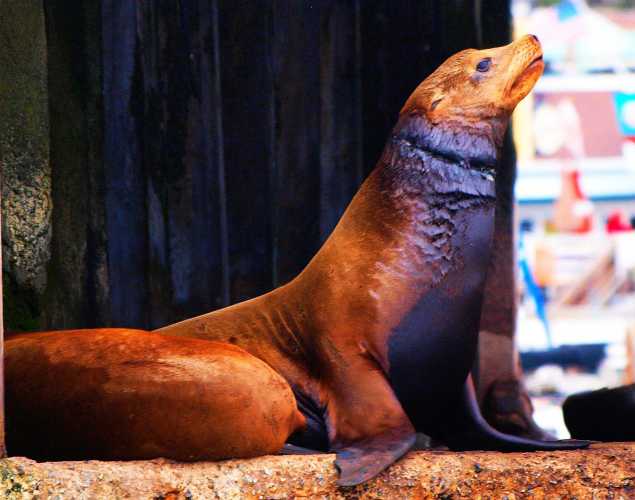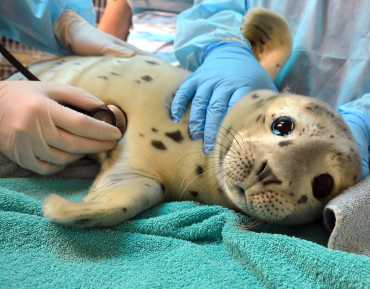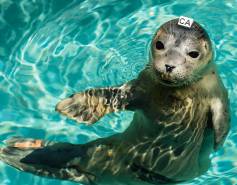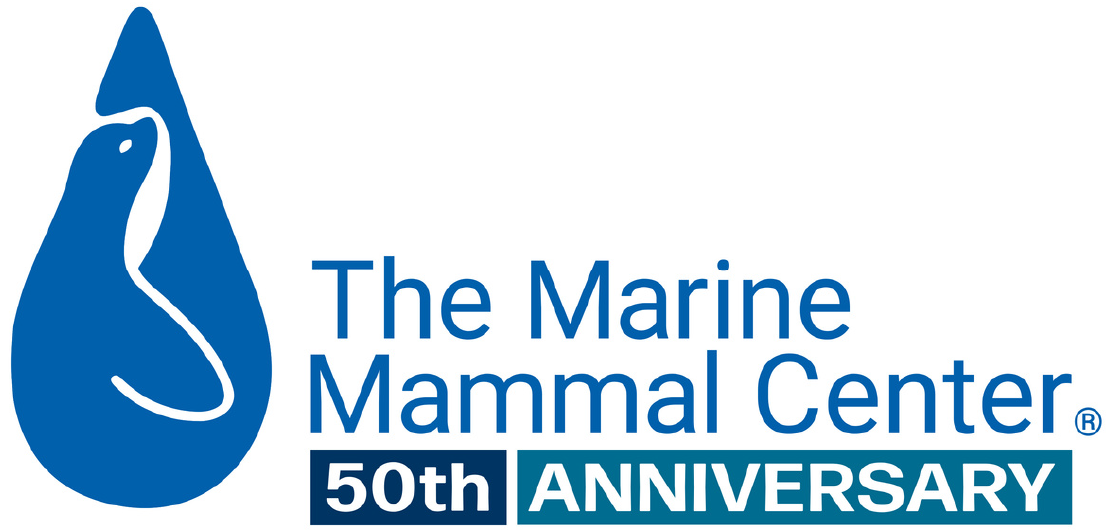
Life-Saving Surgery Frees Thin Mint from Scary Entanglement
- Entanglement
The fishing line wrapped around California sea lion Thin Mint’s neck cut so deeply that it ripped a hole all the way through to his trachea, causing a life-threatening injury that required a delicate surgical procedure.
“This surgery is Thin Mint’s last shot at recovery, but his chances of survival are not good.”
Dr. Cara Field’s words brought a hush over the table of veterinary experts as they sat for their daily patient rounds at The Marine Mammal Center. They nodded their heads in agreement, knowing she was right. Not many at that table had seen a successful outcome for a surgery of this kind—yet it would be the last chance at survival for one of the California sea lions in their care.
A special rescue operation
The sea lion in question was a young adult male named Thin Mint that had been rescued a month prior with monofilament fish netting around his neck. The Marine Mammal Center’s Special Rescue Operations team had spotted him at the Monterey Coast Guard Jetty while on a mission to rescue another entangled animal.
The 228-pound sea lion was active and aggressive when the team approached, so they used a special sedative dart to successfully complete the rescue operation. As Thin Mint dove into the water, they noticed bubbles coming from his neck where the netting was digging into his skin and knew it was a sign of trouble.
The Special Rescue Operations team first stabilized Thin Mint at the Center’s Monterey Bay satellite facility and then transported him directly to our hospital in Sausalito. And it’s a good thing they did. Thin Mint’s entanglement was so severe that it had cut deeply into his neck, causing painful scarring and ripping a hole all the way through to his trachea, or windpipe. Air could be heard hissing through the hole every time he vocalized.
Known as a perforated trachea or a tracheal stoma, this injury is life-threatening for a marine mammal. At any moment, Thin Mint could accidentally aspirate—or suck water directly into his lungs, causing him to drown. The risk of infection is also high with an injury like this because the animal’s lungs are easily accessible by bacteria.
Unfortunately, it’s an injury that is difficult to repair in part because sea lions take rapid, forceful breaths. This high-velocity inhalation allows them to dive for fish in the ocean, but can also tear at scar tissue and prevent a tracheal stoma from closing.
After removing the netting around Thin Mint’s neck, veterinary experts at the Center gave him time to heal on his own, knowing that with the netting removed there was a chance for the hole to close naturally. The team also began consulting with human and veterinary respiratory experts just in case.
A week later, Dr. Field and her team performed a tracheoscopy to see the perforation from the inside and determined that it had not yet closed. During this procedure, an endoscope—a thin, flexible tube with a light and camera on the tip—is inserted through the mouth, into the trachea and down into the lower airways.
As another week passed, daily check-ups continued to show that Thin Mint’s wound had improved as bubbles were no longer seen underwater, but it was not fully healed. Concerned that Thin Mint’s frequent barking was slowing the healing process, the team moved his pen-mates to another location.
Last-Chance Surgery
After four weeks, it was clear to Dr. Field that surgical intervention would be necessary. Without the surgery, Thin Mint would face certain death—it was just a matter of time. Even with the surgery, she knew his chances were not good, but it was her last shot at giving him a second chance at life in the wild.
On July 31, Dr. Tammy Da Costa Gomez, a soft-tissue specialist at Advanced Veterinary Care in Lawndale, California, volunteered her time to perform the delicate surgery to repair Thin Mint’s trachea. Assisted by the veterinary team at the Center, Dr. Da Costa Gomez removed scar tissue to help the area heal properly and then closed the hole in the trachea and closed the muscle and soft tissue surrounding it.
Within a week, Thin Mint was eagerly eating fish again. His sutures were removed several weeks after surgery and the incision held together, indicating to Dr. Field and the Center’s veterinary team that Thin Mint had beaten the odds.
On August 21, Thin Mint was released at Rodeo Beach in Sausalito, California, just steps from the Center’s hospital. He ran toward the water pausing just for a moment at the water line, perhaps realizing how lucky he was, before diving into the waves.
Yes, I want to save a life!

Yes, I want to save a life!
You’ll be giving sick and injured animals the best possible care at the Center’s state-of-the-art hospital. With your gift today, you are giving a patient a second chance at life in the wild.
See Our Latest News
{"image":"\/Animals\/Patients\/Harbor seals\/2020\/cropped-images\/hs-barnwood-by-bill-hunnewell-c-the-marine-mammal-center-315-0-3299-2577-1607370547.jpg","alt":"harbor seal Barnwood","title":"Last-Minute Gift Guide \u2013 Top Gifts that Give Back to Marine Animals","link_url":"https:\/\/www.marinemammalcenter.org\/news\/last-minute-gift-guide","label":"News Update","date":"2025-12-18 01:00:00"}

Last-Minute Gift Guide – Top Gifts that Give Back to Marine Animals
December 18, 2025
Read More{"image":"\/Animals\/Patients\/Hawaiian monk seals\/2025\/cropped-images\/b-ru72admission-to-ke-kai-ola112125photo-c-the-marine-mammal-center-noaa-permit-24359-0-364-1270-992-1766095407.jpg","alt":"A newborn Hawaiian monk seal pup with a black coat in rehabilitative care.","title":"Newborn Hawaiian Monk Seal Pup Now Receiving Care","link_url":"https:\/\/www.marinemammalcenter.org\/news\/newborn-hawaiian-monk-seal-pup-now-receiving-care","label":"Patient Update","date":"2025-12-18 01:00:00"}

{"image":"\/Animals\/Patients\/Hawaiian monk seals\/2025\/cropped-images\/d-ru28release-exam-at-ke-kai-ola111025photo-by-giancarlo-rulli-c-the-marine-mammal-center-noaa-permit-24359-0-0-1270-992-1764620886.jpg","alt":"","title":"Bird Flu Vaccine Trial Offers Hope for Protecting Hawaiian Monk Seals","link_url":"https:\/\/www.marinemammalcenter.org\/news\/bird-flu-vaccine-trial-may-offer-hope-for-protecting-hawaiian-monk-seals","label":"News Update","date":"2025-12-01 08:13:00"}

Bird Flu Vaccine Trial Offers Hope for Protecting Hawaiian Monk Seals
December 1, 2025
Read More{"image":"\/Animals\/Patients\/Hawaiian monk seals\/2021\/hms-pp08-by-sheila-latta-c-the-marine-mammal-center-noaa-permit-18786.jpg","alt":"Hawaiian monk seal","title":"The New York Times: Inside the Bird-Flu Vaccine Trial for Monk Seals","link_url":"https:\/\/www.marinemammalcenter.org\/news\/the-new-york-times-inside-the-bird-flu-vaccine-trial-for-monk-seals","label":"In the News","date":"2025-12-01 01:00:00"}

The New York Times: Inside the Bird-Flu Vaccine Trial for Monk Seals
December 1, 2025
Read More


















